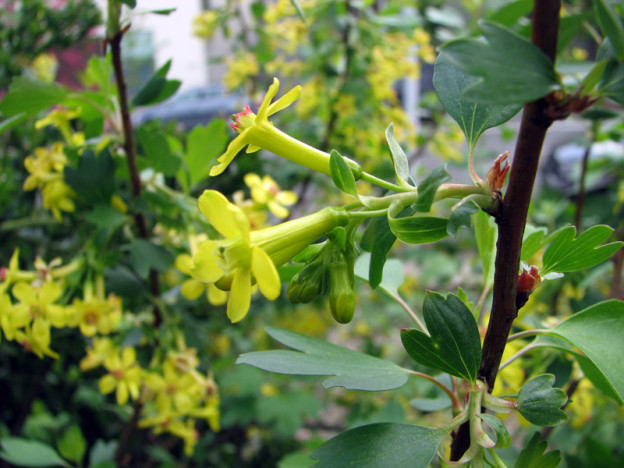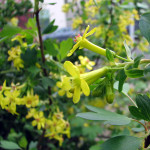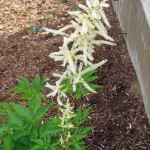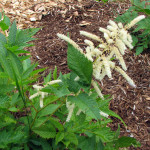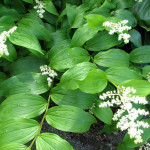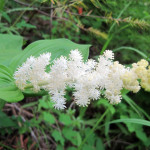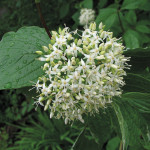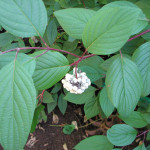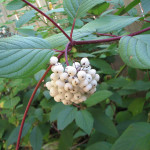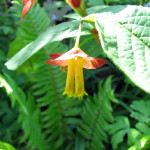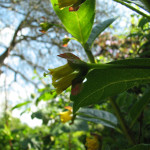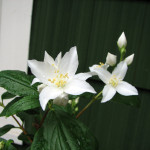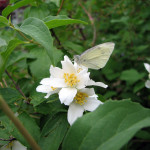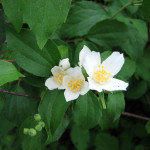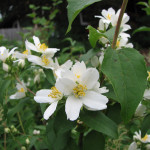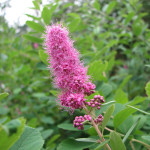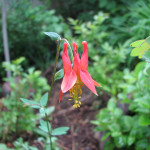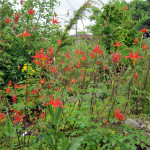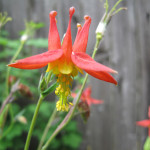Ribes aureum
Golden currant (Ribes aureum) is a small to medium-sized deciduous shrub named for its golden flowers and golden red fall foliage. It is common in Oregon and Washington east of the Cascades and into the Great Basin.
Golden currant grows in full sun and partial shade, in dry to moist conditions, and is drought tolerant. The leaves are deciduous, lobed, and vaguely maple-like, ½ – 1½ inches. Charming clusters of yellow flowers bloom from mid- to late-spring. Golden currant grows to approximately 6 feet tall by 6 feet wide.
It attracts hummingbirds and butterflies such as the spring azure and mourning cloak, and the fruit is eaten by birds and other wildlife. Combine this in a sunny spot with its cousin, red-flowering currant, and drought-tolerant groundcovers like alliums and camas, for a beautiful native display!
- Light Requirements: Full Sun, Part Shade
- Water Requirements: Dry, Moist
- Ease of Growing:
- Growth Rate: Moderate
- Spreads: No
- Wildlife Support: Hummingbirds, Birds or Mammals
- Fire-resistant: No
- Edible: Yes
- Mature Height: 6ft
- Mature Width:6ft
Goat’s Beard

Aruncus dioicus
Goat’s Beard has decorative finely-cut foliage and will create a bold, showy effect for a moist or partly-shaded spot all season. Dense, feathery plumes of tight white flowers rise well above the foliage spring to summer.
Goat’s Beard is an excellent background plant or grouped in a woodland setting. It dies back to the ground in winter, only to return gloriously in the spring. Goat’s Beard spreads slowly by rhizomes to form attractive patches, and can be planted in more sunny areas provided there is good moisture. It’s a “host” plant to the Dusky Azure Butterfly.
- Light Requirements: Part Shade, Full Shade
- Water Requirements: Moist, Perennially Wet
- Ease of Growing: Easy to grow
- Growth Rate: Fast
- Spreads: Yes
- Wildlife Support: Pest-eating Insects, Birds or Mammals, Pollinators
- Fire-resistant: No
- Edible: No
- Mature Height: 5-15ft
- Mature Width:3-5ft
False Solomon’s Seal
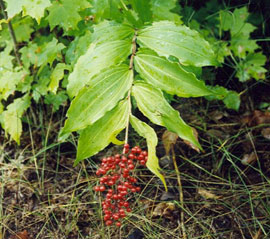
Maianthemum racemosum
False Solomon’s seal is a clump-forming perennial which typically grows 2-3′ tall and slowly spreads by thick rhizomes, often forming large colonies in the wild. Features unbranched, gracefully arching stems of alternate, oval, pointed, light green leaves with conspicuously parallel veins. Tiny, fragrant, creamy white flowers appear at the stem ends in terminal, plumy, spirea-like racemes (hence the species name) in spring.
Flowers are followed by greenish berries which turn an attractive ruby red in summer, often persisting into fall unless earlier consumed by wildlife. Foliage turns yellow in fall. Foliage resembles that of the true Solomon’s seals (Polygonatum spp.), but the latter have distinctly different flowers (i.e., bell-shaped flowers which droop from the leaf axils all along the stems).
- Light Requirements: Part Shade, Full Shade
- Water Requirements: Moist
- Ease of Growing: Easy to grow
- Growth Rate: Moderate
- Spreads:
- Wildlife Support: Pest-eating Insects, Birds or Mammals
- Fire-resistant: Yes
- Edible:
- Mature Height: 1-3ft
- Mature Width:1-2ft
Red-osier Dogwood

Cornus sericea
Red osier dogwood (Cornus sericea) is a medium to tall deciduous shrub. It can grow 6-15 feet tall and 5-10 feet wide depending on site conditions, and spreads to form dense thickets. It is attractive year round with red winter twigs (especially in sunny sites), creamy-white flower clusters, red to purple fall color, and bluish-green to white fruits.
This shrub is excellent for wildlife. Painted lady butterflies visit the flowers for nectar, and spring azure butterflies lay their eggs on the newly developing leaves and buds. Dozens of species of birds and mammals rely on it for food year-round, eating the new shoots in the spring, berries in summer and fall, and twigs through the winter. Birds take cover and nest in the shrubs, and even some amphibians lay more eggs in wetlands with red osier dogwoods than without.
Cuttings readily root, and it is an excellent shrub for improving the health of stream banks and wetlands. In the wild, it commonly grows in wetlands and other habitats with damp soil.
- Light Requirements: Full Sun, Part Shade
- Water Requirements: Moist, Seasonally Wet, Perennially Wet
- Ease of Growing: Easy to grow
- Growth Rate: Fast
- Spreads: Yes
- Wildlife Support: Pollinators, Hummingbirds, Birds or Mammals
- Fire-resistant: Yes
- Edible: No
- Mature Height: 15ft
- Mature Width:6-9ft
Black Twinberry
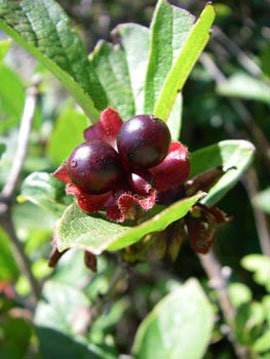
Lonicera involucrata
Black twinberry (Lonicera involucrata) is also known as “twinberry honeysuckle”. Named for its pairs of flowers and fruits, this attractive shrub grows up to 10 feet tall. Tube-shaped yellow to orange flowers bloom April – July, followed by dark purple berries surrounded by showy red bracts. Young branches have yellow bark which age to yellow-brown.
The flowers provide nectar for hummingbirds and bumblebees, and the berries are eaten by numerous birds. Twinberry is also a food plant for the young of Gillette’s Checkerspot butterfly. This wetland plant grows best in sun or partial shade and moist soil.
- Light Requirements: Full Sun, Part Shade
- Water Requirements: Moist, Seasonally Wet
- Ease of Growing: Easy to grow
- Growth Rate: Moderate
- Spreads: No
- Wildlife Support: Pollinators, Hummingbirds, Birds or Mammals
- Fire-resistant: Yes
- Edible: No
- Mature Height: 8-10ft
- Mature Width:4-10ft
Mockorange

Philadelphus lewisii
Mockorange (Philadelphus lewisii) is an elegant native shrub which grows 3-9 feet tall and has a rounded form. The long stems are red when new and fade to gray with age, the older bark shredding in small flakes. Leaves are usually oval, 1-2 inches long, and a medium green.
White flowers start appearing in clusters at the ends of stems after the plant is 3-4 years old. At the height of bloom, older plants are covered in masses of sweet-smelling flowers, which have a scent similar to orange blossoms with a hint of pineapple.
This plant is as popular with wildlife as it is with people. The indra and pale swallowtail butterflies visit it for nectar, as do hummingbirds and many other pollinators. Tiger swallowtails lay their eggs on it. Birds and small mammals eat the seeds and shelter in the foliage.
Mock-orange’s green leaves turn soft yellow in autumn, contrasting beautifully with the dark green of of evergreen huckleberry and red fall foliage of Western viburnum. Add an understory of sword fern for year-round beauty and wildlife value!
- Light Requirements: Full Sun, Part Shade, Full Shade
- Water Requirements: Dry, Moist
- Ease of Growing: Easy to grow
- Growth Rate: Fast
- Spreads:
- Wildlife Support: Pollinators, Pest-eating Insects, Birds or Mammals
- Fire-resistant: Yes
- Edible: No
- Mature Height: 6-10ft
- Mature Width:4-10ft
Douglas Spirea
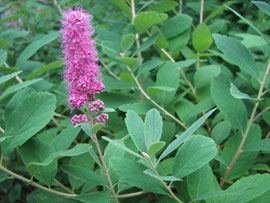
Spiraea douglasii
Also known as hardhack or steeplebush, Douglas spirea (Spiraea douglasii) is best known for its large, pink, pointy clusters of small flowers that bloom from May – July. The flower clusters turn dark in late summer and linger on the plant for months, adding visual interest.
A fast grower that can reach 10-12 feet tall in just a few years, Douglas spirea favors open sunny areas and can tolerate seasonal flooding. It can spread aggressively in moist environments, but is better behaved in drier areas.
Many butterflies visit this plant for nectar and lay their eggs on it, including pale swallowtail, Lorquin’s admiral, spring azure, and mourning cloak.
- Light Requirements: Full Sun, Part Shade
- Water Requirements: Moist, Seasonally Wet
- Ease of Growing: Easy to grow
- Growth Rate: Fast
- Spreads: Yes
- Wildlife Support: Pollinators, Pest-eating Insects, Birds or Mammals
- Fire-resistant: Yes
- Edible: No
- Mature Height: 6ft
- Mature Width:3-7ft
Red Columbine
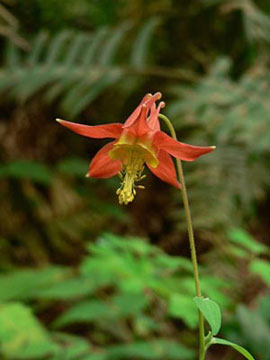
Aquilegia formosa
Red columbine (or Western columbine) is a common and attractive wildflower. It is native to western North America, from Alaska to Baja California and eastward to Montana and Wyoming. The name red columbine is also used for a number of other members of the genus Aquilegia.
Within its range, red columbine can be found across many habitats, including chaparral, oak woodland, and mixed-evergreen or coniferous forest. It prefers moist locations such as stream banks.
The plant grows to 8-48″ in height, averaging around 1-2ft. The red and yellow flowers appear from April to August (with some variation between regions), and are about 5 cm long. The red or orange spreading outer parts of the flower are sepals, and the yellow inner parts are the true petals. The petals bear spurs that attract the plant’s pollinators, sphinx moths.
- Light Requirements: Full Sun, Part Shade
- Water Requirements: Moist
- Ease of Growing: Easy to grow
- Growth Rate: Fast
- Spreads: Yes
- Wildlife Support: Hummingbirds, Pest-eating Insects
- Fire-resistant: Yes
- Edible: No
- Mature Height: 3ft
- Mature Width:1-2ft

